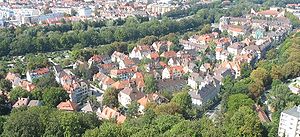Augsburg-Thelottviertel

The Thelottviertel is a district of Augsburg . Together with the Rosenauviertel it forms the city district 15 Rosenau and Thelottviertel , which with its 3000 inhabitants belongs to the planning area Pfersee .
The name of the Thelottviertel goes back to the Augsburg-based goldsmith family Thelott .
Urban significance
The Thelottviertel is considered to be Germany's first “ garden city ”. The name was coined by the British city planner Ebenezer Howard . With his idea of the “garden city”, he was primarily pursuing ideas of social reform.
A colony of single-family houses was laid out on the drained floodplain area, which was new for the time , with spacious front and main gardens and green courtyards. Expediency, attractive form and reasonable building costs were the requirements for the homes near the center.
Between 1907 and 1929 106 single-family houses were built, most of them in row construction. In addition, 76 (multi-family) apartment and commercial buildings were built.
The urban planning concept of the "Buchegger single-family house colony" at that time was based on the designed routing and the varied location of the individually standing or small building groups. It has already been recognized as exemplary by contemporary experts.
Architects
The Thelottviertel was planned and built by the architect Sebastian Buchegger as the first garden suburb in Germany between 1905 and 1929. In view of the lack of contemporary small apartments in Augsburg, Buchegger undertook the development of the area between the main train station and Wertach at his own expense.
The architect Heinrich Sturzenegger (born August 31, 1881 in Ebnat, † December 10, 1961 in Augsburg ) worked at his side . From 1906 to 1914 he worked at the Augsburg “Architecture and Construction Office Sebastian Buchegger”. Besides working on the project planning, his main task was to carry out the construction work.
Others
One of the first completed buildings was the Lenzhalde, then and now a restaurant and hotel. It served as food and accommodation for the construction workers.
The Thelottviertel survived the bombing raids of the Second World War almost unscathed despite its proximity to the main train station . Most of the historical buildings are now under ensemble or monument protection , including the former home of the Buchegger family , which has housed the Swabian Architecture Museum since 1995 .
The architects Buchegger and Sturzenegger are founding members of the Augsburg artists' association “Die Ecke”.
Pictures from the Thelottviertel
Typical architecture in the Thelottviertel (in the background the hotel tower )
Architecture Museum Swabia in the old Buchegger villa
The Rosenaustadion is adjacent to the Thelottviertel
See also
Hellerau is a district, formerly a suburb, of Dresden and is also called the first German garden city. It was the most complete and radical German realization of a garden city in Germany.
The Margarethenhöhe Krupp estate in Essen, which was built in 1910, is also called the first German garden city, but it is only a garden city in terms of its construction.
From 1893 to 1939 around 50 garden cities were built in German-speaking countries .
Web links
Coordinates: 48 ° 21 '43 " N , 10 ° 52' 57" E



